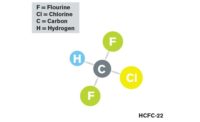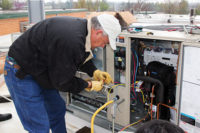Introduced to the U.S. market in 1995, the use of R-410A continues to expand rapidly. Many contractors and technicians have received training on how to properly handle R-410A and install and service new equipment. However, many contractors who have not yet used R-410A may still have questions regarding its safety and handling. The objective of this article is to answer some of the commonly asked safety and handling questions for R-410A.
Safety
R-410A can be used safely when recommended safety and handling practices are followed. The "allowable exposure level" for R-410A is the same as R-22: 1,000 ppm. In general, R-410A should be handled the same as R-22, with the exception of the higher pressure, which will be discussed later. The general hazards of R-410A are the same as other commonly used refrigerants: pressure, frostbite from liquid refrigerant, overexposure to vapors, and deliberate inhalation.Cylinders should be stored in a clean, dry area out of direct sunlight. Storage temperature should not be allowed to exceed 125 degrees F. This includes when cylinders are stored in the back of service trucks and vans. Cylinders should be properly secured when not in use to avoid damage to the cylinder as well as potential injury.
Just like R-22, R-410A can decompose when exposed to high temperatures from flames or electric resistance heaters. Toxic and irritating compounds, such as hydrogen fluoride, can be formed. If this occurs, evacuate the area and ventilate before re-entering the area. If exposed to decomposition products, go to an area with fresh air and seek medical attention.
When brazing or welding, the following minimum guidelines should be followed:
Like R-22, R-410A is nonflammable, but can become combustible if mixed with air at elevated temperature and/or pressure. The required conditions depend on air concentration, pressure, and temperature.
Do not mix R-410A with air for leak testing or other purposes.
A mixture of R-410A and nitrogen can be used for leak testing.

Pressure Of R-410A
The vapor pressure of R-410A is higher than that of R-22. (See Figure 1.) However, other commonly used industrial gases have much higher pressures than R-410A when R-410A is stored in cylinders or when the refrigerant is operating in a system. Oxygen and acetylene are used in cutting torches. Nitrogen is used for purging systems during brazing and welding, and for leak checking.CO2 is commonly used in the beverage industry. Figure 1 shows the pressure in a nitrogen or oxygen cylinder can be as high as 2,500 psig. CO2 is typically shipped and stored in cylinders at 830 psig. The point is that these industrial gases have been used in the HVACR industry for as long as refrigerants and they can be used/handled safely when recommended practices are followed. Even though the cylinder pressure and operating pressure of R-410A are higher than R-22, these pressures are lower than those of other gases that the industry is familiar with and use on a routine basis.

Designed For Safety
A common question is this: Since R-410A has such a high pressure, can I store it in the back of my service van like I did with R-22? The answer is yes.R-410A cylinders meet the same rigorous standards the Department of Transportation (DOT) requires to ensure safe transportation of all compressed gases. A general recommendation that applies to all refrigerants is that if you are storing refrigerant in your van or truck, do not allow the temperature to reach 125 degrees. Temperatures in excess of 125 degrees could result in cylinder contents being released due to activation of the safety relief disk.
Just as the OEMs have re-designed A/C equipment for the higher operating pressures, cylinders for R-410A have been redesigned to handle the higher pressure during normal transportation, use, and handling. Before R-410A was commercially introduced, the leading cylinder manufacturers worked to design a new disposable cylinder.
The result of this effort was an "industry standard" cylinder based on DOT Guideline CFR No. 49. (See Table 1.)
In one example, a cylinder supplier to DuPont, Worthington Cylinders, a division of Worthington Industries, was closely involved in the development program. To ensure that the cylinders meet the design criteria, and to comply with the manufacturing requirements of DOT, Worthington conducts a pressure test on every disposable cylinder made for DuPont™ Suva® 410A. In addition, cylinders are routinely pulled off the production line and subjected to a burst test to make sure they satisfy the 1,000 psig burst pressure criteria.
In regard to recovery cylinders and recovery units, R-410A must be recovered in a high-pressure recovery cylinder. The proper designation for a recovery cylinder is 4BA400; for a half-ton recovery tank, the proper designation is 4BW400. Similarly, recovery units should be rated for R-410A use; check with the manufacturer or your equipment supplier if you have any questions about the rating of your equipment.
And, in regard to manifold gauge sets, they must be rated for the higher pressure of R-410A. There are currently several available to the industry. They will typically have a high side range of 0 to 800 psig, and a low side range of 0 to 300 psig.
POE Lubricants
Let's turn to the safety of POE lubricants. There have been a few isolated complaints that POEs have caused skin rash and irritation. A material safety data sheet (MSDS) for a POE does state the following:"Repeated or prolonged skin contact may result in irritation." Similar statements can also be found on the MSDS for mineral oil and alkylbenzene. All of the data sheets warn against prolonged skin exposure and all provide similar first aid measures: remove contaminated clothing; wash skin with soap and water; wash clothing before re-use; and obtain medical attention if irritation persists.
The point to remember is that all of these lubricants can cause skin irritation with prolonged or repeated exposure. The degree of irritation depends on the length of exposure, the type of lubricant, and, to a large degree, the sensitivity of the person exposed.
This situation can be avoided by practicing good industrial hygiene. Wear impervious gloves and avoid skin contact. If the lubricant does contact the skin, wash thoroughly with soap and water.
In regard to performance, POE lubricants have been used for over 50 years in jet engine maintenance. For the past 12 years, they have been broadly used in a wide range of refrigeration and air conditioning equipment. Currently tens of millions of pieces of equipment use HFCs and POEs, including supermarket display cases, walk-in coolers and freezers, residential and commercial A/C, refrigerators, freezers, transport refrigeration, and ice machines.
A high-quality POE will provide good lubrication and better thermal stability than mineral oils. Although POEs have excellent thermal stability, they can hydrolyze and form small amounts of acid under certain conditions. The degree of hydrolysis will depend on the amount of moisture present, temperature, and time. Hydrolysis can be minimized or eliminated with good manufacturing and service practices, which include:
Conclusion
In properly designed, installed, and maintained systems, R-410A/POE will provide expected performance and long-term durability. The safety and handling considerations for R-410A are very similar to R-22 and many other current refrigerants. When recommended practices are followed, R-410A can be used, stored, and handled safely.Similarly, POE lubricants can be used safely and effectively when supplier's guidelines are followed. The bottom line is to always follow the manufacturer's guidelines for safe use and handling.
Dave Bateman is a senior technical service engineer for DuPont Refrigerants. He can be reached by e-mail at david.j.bateman@usa.dupont.com.
Publication date: 03/07/2005





